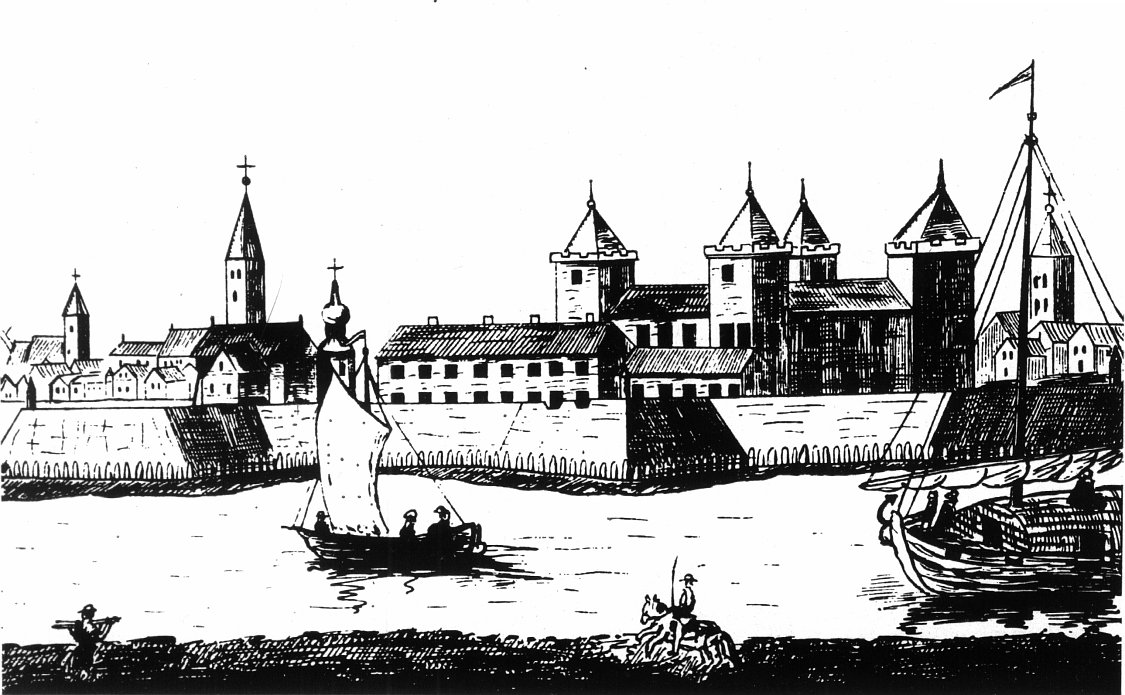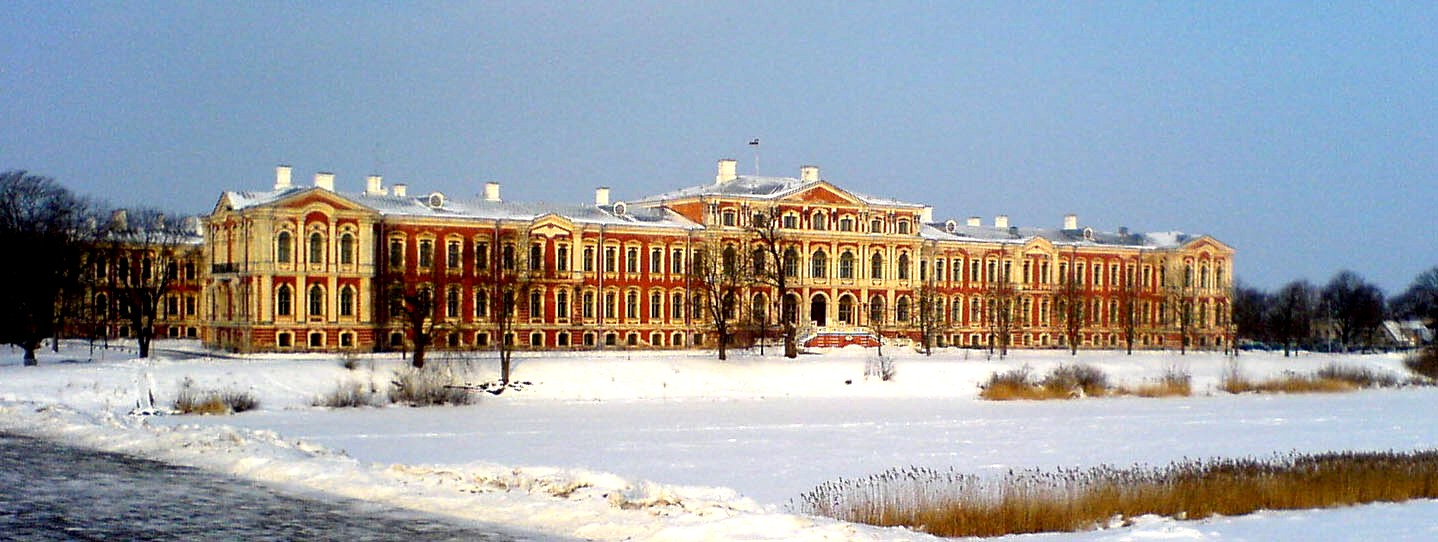|
Jelgava Palace
Jelgava Palace () or historically Mitau Palace (, ) is the largest Baroque-style palace in the Baltic states. It was built in the 18th century based on the design of Bartolomeo Rastrelli as a residence for the Dukes of Courland in their capital of Mitau (today's Jelgava, in the Semigallia region of Latvia). The Dukes of Courland also had a summer palace by Rastrelli, about 40 kilometers to the southeast, called Rundāle Palace. History Construction of the palace started in 1738 on an island between the Lielupe river and its branches. The site had borne the residence of the former Courland dukes of the Kettler dynasty and, before that, a medieval castle belonging to the Livonian Order. Following Ernst Johann von Biron's fall from grace in 1740, all construction work was stopped, even though the roof of the palace had not yet been completed. Most of the building materials and interior elements were moved to St. Petersburg where Rastrelli used them in building of other palaces. ... [...More Info...] [...Related Items...] OR: [Wikipedia] [Google] [Baidu] |
Jelgava
Jelgava () is a state city in central Latvia. It is located about southwest of Riga. It is the largest town in the Semigallia region of Latvia. Jelgava was the capital of the united Duchy of Courland and Semigallia (1578–1795) and was the administrative center of the Courland Governorate (1795–1918). Jelgava is situated on a fertile plain rising only above mean sea level on the right bank of the river Lielupe. At high water, the plain and sometimes the town as well can be flooded. It is a railway center, and is also a host to the Jelgava Air Base. Its importance as a railway centre can be seen by the fact that it lies at the junction of over 6 railway lines connecting Riga to Lithuania, eastern and western Latvia, and Lithuania to the Baltic Sea. Name Until 1917, the city was officially referred to as Mitau. The name of Jelgava is believed to be derived from the Livonian word ''jālgab'', meaning "town on the river." The origin of the German name ''Mitau'' is unclea ... [...More Info...] [...Related Items...] OR: [Wikipedia] [Google] [Baidu] |
Saint Petersburg
Saint Petersburg, formerly known as Petrograd and later Leningrad, is the List of cities and towns in Russia by population, second-largest city in Russia after Moscow. It is situated on the Neva, River Neva, at the head of the Gulf of Finland on the Baltic Sea. The city had a population of 5,601,911 residents as of 2021, with more than 6.4 million people living in the Saint Petersburg metropolitan area, metropolitan area. Saint Petersburg is the List of European cities by population within city limits, fourth-most populous city in Europe, the List of cities and towns around the Baltic Sea, most populous city on the Baltic Sea, and the world's List of northernmost items#Cities and settlements, northernmost city of more than 1 million residents. As the former capital of the Russian Empire, and a Ports of the Baltic Sea, historically strategic port, it is governed as a Federal cities of Russia, federal city. The city was founded by Tsar Peter the Great on 27 May 1703 on the s ... [...More Info...] [...Related Items...] OR: [Wikipedia] [Google] [Baidu] |
West Russian Volunteer Army
The West Russian Volunteer Army or Bermontians was a pro-German White Russian military formation in Latvia and Lithuania during the Russian Civil War from November 1918 to December 1919. History The , unlike the pro- Entente Volunteer Army in Southern Russia, was supported and in fact put together under German auspices. The Compiègne Armistice of November 1918, in article 12, stipulated that troops of the former German Empire would remain in the Baltic provinces of the former Russian Empire to help fight against Bolshevik advances and that such German units were to withdraw once the Allies determined that the situation was under control. The order to withdraw was given after signing of the Treaty of Versailles in June 1919. However, only a small portion of the Freikorps in the Baltic retired in response to the Allies' order; the rest remained under the leadership of the German Army General Rüdiger von der Goltz. To avoid casting blame on Germany and infuriating the Al ... [...More Info...] [...Related Items...] OR: [Wikipedia] [Google] [Baidu] |
Napoleon
Napoleon Bonaparte (born Napoleone di Buonaparte; 15 August 1769 – 5 May 1821), later known by his regnal name Napoleon I, was a French general and statesman who rose to prominence during the French Revolution and led Military career of Napoleon, a series of military campaigns across Europe during the French Revolutionary and Napoleonic Wars from 1796 to 1815. He led the French First Republic, French Republic as French Consulate, First Consul from 1799 to 1804, then ruled the First French Empire, French Empire as Emperor of the French from 1804 to 1814, and briefly again in 1815. He was King of Italy, King of Kingdom of Italy (Napoleonic), Italy from 1805 to 1814 and Protector of the Confederation of the Rhine, Protector of the Confederation of the Rhine from 1806 to 1813. Born on the island of Corsica to a family of Italian origin, Napoleon moved to mainland France in 1779 and was commissioned as an officer in the French Royal Army in 1785. He supported the French Rev ... [...More Info...] [...Related Items...] OR: [Wikipedia] [Google] [Baidu] |
Courland Governorate
Courland Governorate, also known as the Province of Courland or Governorate of Kurland, and known from 1795 to 1796 as the Viceroyalty of Courland, was an administrative-territorial unit (''guberniya'') and one of the Baltic governorates of the Russian Empire. Its area roughly corresponded to Kurzeme, Zemgale and Sēlija of modern-day Latvia. History The governorate was created in 1795 out of the territory of the Duchy of Courland and Semigallia, which was incorporated into the Russian Empire as the Viceroyalty of Courland with its capital at Jelgava, Mitau (now Jelgava) following the Partitions of Poland, third partition of the Polish–Lithuanian Commonwealth. In 1915, during the World War I Courland was occupied by the German Empire. With the Treaty of Brest-Litovsk on 3 March 1918, Russian Soviet Federative Socialist Republic, Bolshevik Russia accepted the loss of the Courland Governorate. After an attempt to reestablish the Duchy of Courland and Semigallia (1918), Duchy ... [...More Info...] [...Related Items...] OR: [Wikipedia] [Google] [Baidu] |
Versailles
The Palace of Versailles ( ; ) is a former royal residence commissioned by King Louis XIV located in Versailles, Yvelines, Versailles, about west of Paris, in the Yvelines, Yvelines Department of Île-de-France, Île-de-France region in France. The palace is owned by the government of France and since 1995 has been managed, under the direction of the Ministry of Culture (France), French Ministry of Culture, by the Public Establishment of the Palace, Museum and National Estate of Versailles. About 15,000,000 people visit the palace, park, or gardens of Versailles every year, making it one of the most popular tourist attractions in the world. Louis XIII built a hunting lodge at Versailles in 1623. His successor, Louis XIV, expanded the château into a palace that went through several expansions in phases from 1661 to 1715. It was a favourite residence for both kings, and in 1682, Louis XIV moved the seat of his court and government to Versailles, making the palace the ''de fact ... [...More Info...] [...Related Items...] OR: [Wikipedia] [Google] [Baidu] |
Louis XVIII Of France
Louis XVIII (Louis Stanislas Xavier; 17 November 1755 – 16 September 1824), known as the Desired (), was King of France from 1814 to 1824, except for a brief interruption during the Hundred Days in 1815. Before his reign, he spent 23 years in exile from France beginning in 1791, during the French Revolution and the First French Empire. Until his accession to the throne of France, he held the title of Count of Provence as brother of King Louis XVI, the last king of the ''Ancien Régime''. On 21 September 1792, the National Convention abolished the monarchy and deposed Louis XVI, who was later executed by guillotine. When his young nephew Louis XVII died in prison in June 1795, the Count of Provence claimed the throne as Louis XVIII. Following the French Revolution and during the Napoleonic era, Louis XVIII lived in exile in Prussia, Great Britain, and Russia. When the Sixth Coalition first defeated Napoleon in 1814, Louis XVIII was placed in what he, and the French ... [...More Info...] [...Related Items...] OR: [Wikipedia] [Google] [Baidu] |
Russian Empire
The Russian Empire was an empire that spanned most of northern Eurasia from its establishment in November 1721 until the proclamation of the Russian Republic in September 1917. At its height in the late 19th century, it covered about , roughly one-sixth of the world's landmass, making it the list of largest empires, third-largest empire in history, behind only the British Empire, British and Mongol Empire, Mongol empires. It also Russian colonization of North America, colonized Alaska between 1799 and 1867. The empire's 1897 census, the only one it conducted, found a population of 125.6 million with considerable ethnic, linguistic, religious, and socioeconomic diversity. From the 10th to 17th centuries, the Russians had been ruled by a noble class known as the boyars, above whom was the tsar, an absolute monarch. The groundwork of the Russian Empire was laid by Ivan III (), who greatly expanded his domain, established a centralized Russian national state, and secured inde ... [...More Info...] [...Related Items...] OR: [Wikipedia] [Google] [Baidu] |
Alessandro Cagliostro
Giuseppe Balsamo (; 2 June 1743 – 26 August 1795), known by the alias Count Alessandro di Cagliostro ( , ), was an Italian occultist and confidence trickster. Cagliostro was an Italian adventurer and self-styled magician. He became a glamorous figure associated with the royal courts of Europe where he pursued various occult arts, including psychic healing, alchemy, and scrying. His reputation lingered for many decades after his death but continued to deteriorate, as he came to be regarded as a charlatan and impostor, this view fortified by the savage attack of Thomas Carlyle (1795–1881) in 1833, who pronounced him the "Quack of Quacks". Later works—such as that of W. R. H. Trowbridge (1866–1938) in his ''Cagliostro: the Splendour and Misery of a Master of Magic'' (1910), attempted a rehabilitation. Biography Origin The history of Cagliostro is shrouded in rumour, propaganda, and mysticism. Some effort was expended to ascertain his true identity when he was arreste ... [...More Info...] [...Related Items...] OR: [Wikipedia] [Google] [Baidu] |






